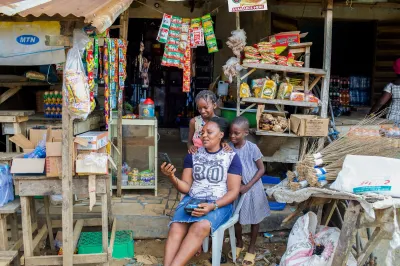Fintech in the Arab World: Toward Gender Parity in 15, Not 150, Years
Gender inequality is a constant reminder of the work to be done in the Arab World. The World Economic Forum’s (WEF) Global Gender Gap Report 2020, which tracks gender parity in health, education, the economy and politics, ranks the region as having the world’s largest gender gap. According to the report, it would take 150 years for the region to achieve gender parity at its current rate of progress. CGAP’s research on fintech in the Arab World reveals how gender inequality is playing out in the region’s nascent fintech space. With some notable exceptions, very few fintechs in the region are offering solutions that would help close the gender gap.
Fintech’s growing potential to help close the gender gap is not yet realized
The gender gap in account ownership across the Arab World stands at 17 percentage points, according to the latest Global Findex data. The rapid growth of the region’s fintech sector presents an opportunity to bridge this gap on a large scale, especially as the region has a lower mobile phone ownership gender gap than Sub-Saharan Africa or South Asia (9 percent, according to GSMA data). The relatively high rate of phone ownership among women points to the role that fintechs could play in offering digital financial services that meet women’s needs.
Adding to fintechs’ potential are record levels of investment in the region and COVID-19-era regulations that have reduced onboarding requirements and increased transaction limits. With all this support, fintechs in the region have the capacity to advance financial inclusion by offering efficient and customer-centric solutions to previously underserved markets.
Of the 400 fintechs CGAP has identified in the Arab World, just 2 percent specifically mention women in their mission statements.
By and large, however, the fintech sector has not focused on closing the gender gap. Of the 400 fintechs CGAP has identified in the Arab World, just 2 percent specifically mention women in their mission statements. As the sector continues to grow, it can avoid perpetuating the same inequalities that dominate traditional financial services. To do so, more fintechs will need to adopt more gender-intelligent approaches that tackle common challenges facing women. For instance, 86 percent of fintech solutions in the region currently require users to have a smartphone or internet access, but women use mobile internet 21 percent less than men. Global evidence shows that gender-intelligent design can help providers make financial services work better for women, ultimately driving higher usage among all genders.
Some fintechs are piloting the business case for gender-intelligent services
The gender-focused solutions that do exist in the region are being developed by mature fintechs partnering with gender-aware players and by early-stage fintechs placing gender at the core of their missions. Initiatives are often still at pilot stage. It will be interesting to monitor whether they grow into viable business cases and fuel gender-focused innovation at scale.
The Arab Women’s Enterprise Fund (AWEF) has been instrumental in initiating and documenting a number of these initiatives, ranging from mobile wallets adoption to merchant payment integration. Its "Eight Lessons from the Field" report emphasizes the need for fintechs to take a deliberate approach to meeting the needs of women. A simple first step is to collect and publish sex-disaggregated data that helps debunk myths about women’s financial needs. This is where policy makers, market bodies and their international partners play a key role alongside fintechs. For instance, IFC’s Women Banking Champions program is enabling gendered data reporting from banks and financial institutions in Morocco, Tunisia and Algeria.
Deliberate approaches to targeting women, such as specific incentive programs and marketing campaigns, pay off. In Jordan, joint research by the Jordan Payments and Clearing Company (JoPACC) and AWEF documents how mobile wallet provider Zain Cash introduced a transaction-based loyalty program for women. It also describes the experience of Mahfazati (now uWallet) with implementing a program in which female users who made a certain number of transitions were eligible to win a monthly prize. Initial results show that these initiatives, coupled with women-led activities to raise awareness on mobile wallet benefits, increased wallet usage by up to 38 percent. Since women value their peers’ opinions and tend to require in-depth information when adopting new financial products, these experiments unsurprisingly worked best when women, either community leaders or agents, helped guide other women through the onboarding process.
Gender-intelligent initiatives in the region also include efforts to make agent networks work better for women. Most financial services agents are male, and prevailing social norms can make this a barrier for women. Some mature fintechs, such as payments service providers Dinarak in Jordan and Fawry in Egypt, have rolled out female agents networks to address this issue. Both initiatives increased female agent onboarding rates but faced several challenges, including the identification of female agents, lower levels of digital financial literacy that increase training needs, and social norms discouraging women from serving as agents. Overcoming these challenges required a substantial investment in training and incentives, such as providing home-based female-led businesses with a wider range of products to increase their transaction volumes.
We have also identified initiatives that seek to improve women’s digital financial skills and design services around their lower income levels. For example, CIWA in Morocco has pivoted away from its core rotating savings and credit association solution to develop literacy programs. In a country where female literacy rate only stood at 65 percent in 2018, this kind of initiative might lay the foundation for more women’s adoption of financial services. In rural Tunisia, Ahmini allows women to access health care by fractioning their social security dues into many small payments and then aggregating micro-payments on their behalf.
It is striking that only 20 percent of fintechs in the region tackle an important barrier for entrepreneurs, in general, and for women in particular: access to finance. This percentage is even smaller in the region’s developing countries, where microfinance institutions (MFIs) continue to spearhead financing for low-income female entrepreneurs. Collaboration between fintechs and MFIs is still nascent. In Egypt, AWEF partnered with Paymob to offer point-of-sale devices to women clients of a local MFI, Tamweely, for a free trial period. These devices have allowed Tamweely customers to digitize the operations of their small businesses while providing the MFI with transactional data that can help it address the needs of female clients.
Gender parity for the next generation of Arab women is possible
For fintech to realize its potential to help close Arab World’s gender gap, more fintechs must follow in the footsteps of these innovators, both large and small. The COVID-19 pandemic is proving to be a decelerator for women’s rights and gender equality globally, but it doesn’t have to be. If fintech solutions in the Arab World receive the support they need to grow, and if more fintechs start designing gender-intelligent services, then the region will be able to leverage its full potential to advance financial inclusion for all, women and men alike.




Add new comment